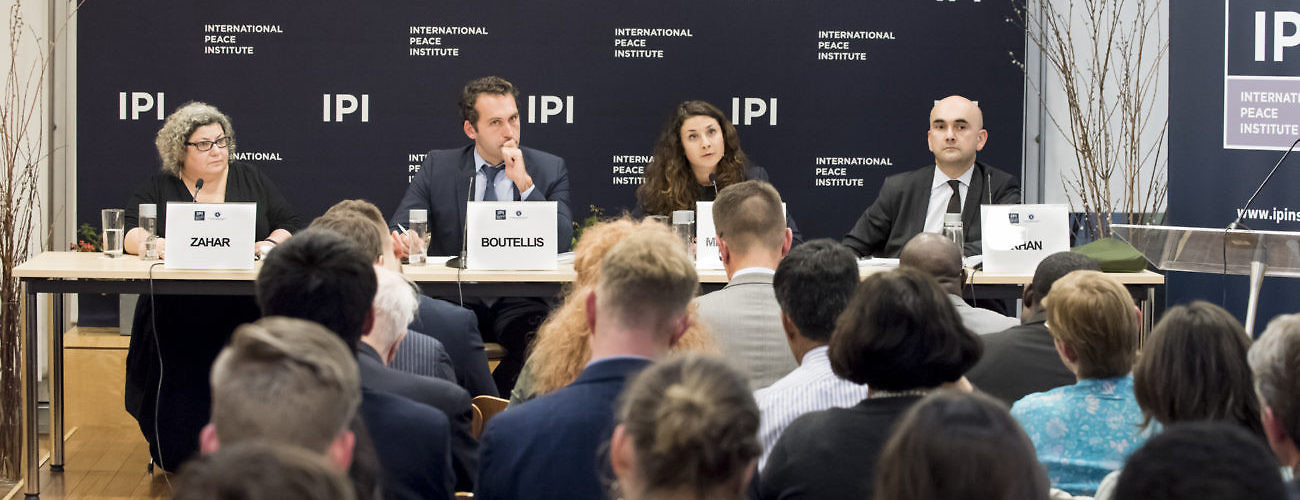On November 6th, Marie-Joëlle Zahar, IPI Senior Fellow, and Delphine Mechoulan, IPI Policy Analyst, presented the main findings of their report “Peace by Pieces? Local Mediation Initiatives and Sustainable Peace in the Central African Republic.”
The report, which by can be found here, describes and analyzes the impact of local mediation activities in the Central African Republic, and formulates specific recommendations for the UN Secretariat and the Security Council ahead of the UN Multidimensional Integrated Stabilization Mission in the Central African Republic (MINUSCA) mandate renewal on November 15th.
Arthur Boutellis, Director of the Brian Urquhart Center for Peace Operations, opened the discussion by emphasizing that “the only sustainable, and possibly less costly way to reach peace is through political solutions at all levels.”
Jouni Laaksonen, Deputy Permanent Representative of Finland to the UN, stressed that local dialogues have proven useful in situations where formal processes are deadlocked, but that “ways of linking them to the formal national process remain difficult.”
In his opening remarks, Marcien Aubin Kpatamango, Deputy Permanent Representative of CAR to the UN, underlined the importance of reconciling peace initiatives at the local and national level as the country emerges from a five-year conflict.
Dr. Zahar said that the initiatives, while useful in their own right, did not necessarily add up to more than the sum of their parts for three main reasons; their ad hoc nature, the lack of a concerted national strategy to link various local initiatives to government-led mediation efforts, and their short-term, localized results.
When trying to bridge the gap between local and national initiatives, “the government finds itself between a rock and a hard place,” she said, “needing to maintain public support but at the same time hampered and constrained by the lack of an embrace of reconciliation by the population.”
As for the local results, “there are real gains,” she said, “but these gains have not paved the way for more durable reconciliation or the return of displaced Central Africans to their homes and places of origin.”
In her remarks, Ms. Mechoulan described the diversity of mediation initiatives and the commitments armed groups and communities make in these pacts, which include the adherence of armed groups to the cessation of hostilities, weapon-free zones, the free movement of persons and goods, noninterference in the activities of public services, and the protection of private property.
Ms. Mechoulan added, however, that these initiatives also have a number of limits and potential risks– for example, the pact that was signed in Batangafo, successfully halted violence but its impact was limited to the town itself and therefore very localized, and Bambari, where, after a pact was signed in 2016, violence quickly resumed and was displaced from one locality to the other.
Ms. Mechoulan also recommended using MINUSCA to connect the various local initiatives to the larger national reconciliation process, due to its far reach throughout the country, particularly its field offices.
Asif Khan, Chief of Mediation Support at the United Nations Department of Political Affairs, stressed that one of the basic dilemmas in the Central African Republic was the fragmentation of armed groups, making a single comprehensive agreement “neither feasible nor capable of resolving the multiplicity of conflicts in the country.”
Speaking more broadly about the role of the UN in mediation, he highlighted that “We have to aim to try not to do local mediation in an ad hoc manner or with limited objectives.”
The event was co-sponsored by the Permanent Mission of Finland to the United Nations.
Arthur Boutellis, Director of the Brian Urquhart Center for Peace Operations moderated the discussion.








